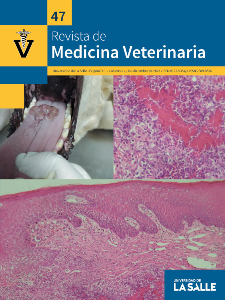Abstract
<p>A tool was developed to assess vulnerability to food fraud in plants that manufacture and process animal products for human consumption. It was decided to name the generated instrument EVUFA (Food Fraud Vulnerability Assessment). The questionnaire was submitted to a validation process by 15 professionals from the food industry, using a 3 variable Likert scale. To validate the EVUFA, content validity was performed using the modified Lawshe method, discarding 6 questions that did not exceed the minimum value. In addition, the measurement of reliability using the Cronbach’s alpha statistic was 0,93. A case study was carried out applying the EVUFA in 2 food processing plants, which obtained a score of 60,5 and 51, respectively. Consequently, they were rated with a moderate vulnerability to food fraud.</p>References
Comisión del Codex Alimentarius. El fraude alimentario: respuesta ante sus riesgos, prevención y contramedidas. Trigésima primera reunión. Roma, Italia: Organización Mundial de la Salud - Organización de las Naciones Unidas para la Alimentación y la Agricultura; 2019. Disponible en: https://www.fao.org/fao-who-codexalimentarius/sh-proxy/de/?lnk=1&url=https%253A%252F%252Fworkspace.fao.org%252Fsites%252Fcodex%252FMeetings%252FCX-706-31%252FWD%252Feu31_02s.pdf
Yang Y, Huisman W, Hettinga KA, Zhang L, van Ruth SM. The Chinese milk supply chain: A fraud perspective. Food Cont. 2020;113: 107211. Disponible en: https://doi.org/10.1016/j.foodcont.2020.107211
Spink J, Hegarty PV, Fortin ND, Elliott CT, Moyer DC. The application of public policy theory to the emerging food fraud risk: Next steps. Tre Food Sci Tech. 2019;85: 116-128. Disponible en: https://doi.org/10.1016/j.tifs.2019.01.002
Callao MP, Ruisánchez I. An overview of multivariate qualitative methods for food fraud detection. Food Cont. 2018;86: 283-293. Disponible en: https://doi.org/10.1016/j.foodcont.2017.11.034
FAO. Food fraud – Intention, detection and management. Food safety technical toolkit for Asia and the Pacific. No. 5. Bangkok: FAO; 2021. Disponible en: https://www.fao.org/3/cb2863en/cb2863en.pdf
FAO. Thinking about the future of food safety – A foresight report. Rome: FAO; 2022. Disponible en: https://doi.org/10.4060/cb8667en
Robson K, Dean M, Haughey S, Elliott C. A comprehensive review of food fraud terminologies and food fraud mitigation guides. Food Cont. 2020: 107516. Disponible en: https://doi.org/10.1016/j.foodcont.2020.107516
Cartín-Rojas A. Food fraud and adulteration: a challenge for the foresight of Veterinary Services. Rev Sci Tech Off Int Epiz. 2017;36(3): 1015-1024. Disponible en: https://doc.oie.int/dyn/portal/digidoc.xhtml?statelessToken=MjIvlKFvg0PtWNYJEv2-gwtfugQGzKFNwFgniet6WNE=&actionMethod=dyn%2Fportal%2Fdigidoc.xhtml%3AdownloadAttachment.openStateless
Soon JM, Krzyzaniak SC, Shuttlewood Z, Smith M, Jack L. Food fraud vulnerability assessment tools used in food industry. Food Cont. 2019;101: 225-232. Disponible en: https://doi.org/10.1016/j.foodcont.2019.03.002
Díaz Porras RA, Cartín Rojas A, Alvarado Ruiz JM. Programa de compras institucionales en Costa Rica: Política productiva cuestionada pero socialmente necesaria. Perspect Rur. 2020;18(36): 49-76. Disponible en http://doi.org/10.15359/prne.18-36.3
Van Ruth SM, Nillesen O. Which Company Characteristics Make a Food Business at Risk for Food Fraud? Foods. 2021;10(4): 842. Disponible en: http://doi.org/10.3390/foods10040842
Van Ruth SM, Luning PA, Silvis ICJ, Yang Y, Huisman W. Differences in fraud vulnerability in various food supply chains and their tiers. Food Cont. 2018;84, 375-381. Disponible en: http://doi.org/10.1016/j.foodcont.2017.0
Cadieux B, Goodridge LD, Spink J. Gap analysis of the Canadian food fraud regulatory oversight and recommendations for improvement. Food Cont. 2019;102: 46-55. Disponible en: https://doi.org/10.1016/j.foodcont.2019.03.012
Espinoza T, Mesa FR, Valencia E, Quevedo R. Tipos de fraude en carnes y productos cárnicos: una revisión. Sci Agro. 2015;6(3). Disponible en: http://www.scielo.org.pe/scielo.php?script=sci_arttext&pid=S2077-99172015000300009&lang=es
Brooks C, Parr L, Smith JM, Buchanan D, Snioch D, Hebishy E. A review of food fraud and food authenticity across the food supply chain, with an examination of the impact of the COVID-19 pandemic and Brexit on food industry. Food Cont. 2021;130: 108171. Disponible en: https://doi.org/10.1016/j.foodcont.2021.108171
Spink J, Moyer D. Defining Public Health Threat of Food Fraud. J Food Sci. 2011;76(9): R157-R163. Disponible en: https://doi.org/10.1111/j.1750-3841.2011.02417.x
Ulberth F. Tools to combat food fraud – A gap analysis. Food Chem. 2020;15(330): 127044. Disponible en: https://doi.org/10.1016/j.foodchem.2020.127044
Kendall H, Clark B, Rhymer C, Kuznesof S, Hajslova J, Tomaniova M, et al. A systematic review of consumer perceptions of food and authenticity: A European perspective. Tre Food Sci Tech. 2019;94: 79-90. Disponible en: https://doi.org/10.1016/j.tifs.2019.10.005
Sanabria Quesada A. Defensa y Fraude Alimentario: Motivaciones diferentes que generan un mismo resultado [Internet]. Rev Alime Cám Costarric Indus Alim. 2021, febrero. Disponible en: http://alimentaria.cacia.org/digital/defensa-y-fraude-alimentario-motivaciones-diferentes-que-generan-un-mismo-resultado/
Barrere V, Everstine K, Théolier J, Godefroy S. Food fraud vulnerability assessment: Towards a global consensus on procedures to manage and mitigate food fraud. Tre Food Sci Tech. 2020;100: 131-137. Disponible en: https://doi.org/10.1016/j.tifs.2020.04.002
Gao B, Holroyd SE, Moore JC, Laurvick K, Gendel SM, Xie Z. Opportunities and challenges using non-targeted methods for food fraud detection. J Agric Food Chem. 2019;67(31): 8425-8430. Disponible en: https://doi.org/10.1021/acs.jafc.9b03085
Van Ruth SM, Huisman W, Luning, PA. Food fraud vulnerability and its key factors. Tre Food Sci Tech. 2017;67: 70-75. Disponible en: doi: https://doi.org/10.1016/j.tifs.2017.06.017
Rezazade F, Summers J, Lai Teik DO. A holistic approach to food fraud vulnerability assessment. Food Cont. 2022;131: 108440. Disponible en: https://doi.org/10.1016/j.foodcont.2021.108440
FDA FSMA Final Rule for Mitigation Strategies to Protect Food Against Intentional Adulteration [Internet]. US Food & Drug Administration. 2022, marzo 11. Disponible en: https://www.fda.gov/food/food-safety-modernization-act-fsma/fsma-final-rule-mitigation-strategies-protect-food-against-intentional-adulteration
Spink J, Elliott C, Dean M, Speier-Pero C. Food fraud data collection needs survey. Npj Sci Food. 2019;3(1): 8. Disponible en: https://doi.org/10.1038/s41538-019-0036-x
Manning L, Soon JM. Food fraud vulnerability assessment: Reliable data sources and effective assessment approaches. Tre Food Sci Tech. 2019;91. 159-168. Disponible en: https://doi.org/10.1016/j.tifs.2019.07.007
Herrera A. Vulnerabilidad de la industria de lácteos al fraude alimentario. Rev Uni Téc Nac Info. 2018;XX(82 mayo-agosto): 16-19. Disponible en: https://www.utn.ac.cr/sites/default/files/attachments/REVISTA%2082.pdf
Silvis ICJ, van Ruth SM, van der Fels-Klerx HJ, Luning PA. Assessment of food fraud vulnerability in the spices chain: An explorative study. Food Cont. 2017;81: 80-87. https://doi.org/10.1016/j.foodcont.2017.05.019
U.S. Department of Health and Human Services Food and Drug Administration Center for Food and Applied Nutrition. Mitigation Strategies to Protect Food Against Intentional Adulteration: Guidance for Industry. U.S. Department of Health and Human Services Food and Drug Administration Center for Food and Applied Nutrition; 2020. Disponible en: https://www.fda.gov/media/135122/download
Moerman F. Chapter 5 - Food Defense. En: Holban AM, Mihai A (eds.), Food Control and Biosecurity. Elsevier; 2018. p. 135-223. Disponible en: https://doi.org/10.1016/b978-0-12-811445-2.00005-2
Catlin M, Kautter D. An Overview of the Carver Plus Shock Method for Food Sector Vulnerability Assessments. Washington: Food Safety and Quality Service; 2009. Disponible en: https://ntrl.ntis.gov/NTRL/dashboard/searchResults/titleDetail/PB2009104873.xhtml
